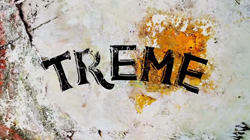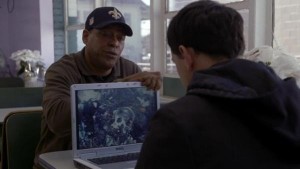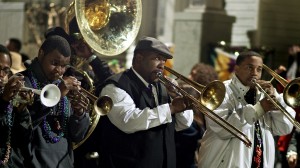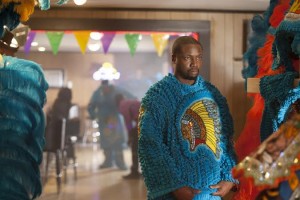David Simon’s Treme, the American auteur’s loving and unflinching portrait of New Orleans, is now history after Sunday’s final episode. People compare it to his masterpiece, The Wire, which similarly lacked big viewership numbers while it was running, but became a cult hit once it was over. Treme is a different animal from The Wire, but the two shows will continue to be linked if only for the strength of the performances of its two common actors, Wendell Pierce and Clarke Peters.
Ironically, both actors turn in stronger performances in Treme than they did in The Wire. Antoine Batiste, the ne’er-do-well trombonist who Pierce plays so forcefully and humorously in Treme, is the most fully developed character in Treme’s storyline. The growth that he displays over the course of the four season as he discovers his purpose in life and the meaning of his family relationships is one of the narrative triumphs of the series. While many character story lines have definitive endings, or, as in the case of Davis McAlary and Janette Desautel, end up more or less where they started, Antoine Batiste feels like a character with much more in store for him.
Big Chief Albert Lambreaux’s character in Treme seems doomed from the start, but the steely resolve and outright defiance Peters brings to the role is a high point in American television, Shakespearian in its tragic dignity. The critics who were unmoved by his performance complained that it wasted too much effort on insignificant details like the Black Indian custom of laboriously sewing suits for Mardi Gras day, but such willful ignorance of the importance of ritual in culture is no longer germane now that the show has become part of history.
Time will only ripen the contours of this story, a tale about real people fighting against a political system bent on destroying them. New Orleans was almost completely depopulated after the 2005 flood that followed Hurricane Katrina when most of the city’s levee system failed and nearly all of its housing was ruined or damaged. Citizens were not permitted to return to the city for months after the flood, during which time New Orleans was literally occupied by the National Guard and a haphazardly-organized police force from all over the country.
This is the first time in history a major American city was depopulated in this fashion. Reacting to the disaster, rebuilding the city and restoring its citizens to their homes became a sociological proving ground and a textbook-worthy example of urban planning.
Those citizens were betrayed from the moments the levees failed by every level of government. Tens of thousands were abandoned, some to die of thirst and lack of medical care, in the first week after the flood as rescue efforts took a backseat to shoot-to-kill behavior from a police force in chaos. The mostly black residents of the city were sent to far-off locations and given no aid or encouragement to return. For many of those residents, this was the final chapter in a generations-long Diaspora from their ancestral homes in Africa.
Treme took on the task of telling this story from two perspectives – the determination of those who returned after the flood to piece their lives back together and restore their unique culture, which was threatened with extinction; and the cravenness of those in power who used the disaster to brutalize the victims and/or enhance their own wealth. Several character stories, like the fate of newbie Annie, floated along without satisfactory resolution, but the issue stories, like the collapse of the city’s education system, real estate development scams that exploited the poorest residents, unchecked street-gang violence and a police force that behaved like one of the street gangs itself were handled with the same deft police reporter’s eye that Simon demonstrated in The Wire.
That eye managed to capture what may be the most difficult subject matter a storyteller can take on, telling the story of a city, which Simon did so brilliantly with Baltimore in The Wire. New York has its Mean Streets and Annie Hall, works in which the city itself was one of the main characters. But after countless films, television shows and videos have used New Orleans clumsily as a bacchanalian backdrop, this city has remained a place that defied capture – until now. The depiction was always skewed, often laughably. New Orleans had been best described, it seemed, in print, where the imagination left just enough room for the numinous parts of the city’s soul to seep in. Treme finally captures some of that soul visually. The city itself is the most important character in the series.
Of course the people who live in and run the city are the ultimate determinants of its character, and Treme dramatized the efforts of the citizens with the least power to prevent their culture from being wiped out by those with the most power. That is an ongoing story. Right now we are watching New Orleans change into something unrecognizable before our eyes. Developers are calling the shots in neighborhoods around the city, changing the nature of its housing stock. National chains are driving out local merchants. The New Orleans city council is inexplicably pushing a noise ordinance that will effectively allow second lines, brass bands and any unauthorized parades to be outlawed. Louisiana governor Bobby Jindal has cut off funding to the Musicians Clinic as of January 1, effectively pronouncing a death sentence on some of the city’s greatest musical resources. Mardi Gras Indian icon Bo Dollis, who relies on the Clinic for his dialysis treatments, is one of the most prominent city elders at immediate risk. Jindal is also responsible for the evisceration of the city’s music education programs, which are key elements in providing alternatives for young people to joining violent street gangs.
Treme chose to draw attention to all the above problems as an element of its narrative. In a world of light entertainment and escapism, David Simon and his co-producer Eric Overmyer wanted to say something meaningful about one of the most important cities in the last 500 years of human history. In that sense, Treme is far more than an American story. It’s a story about humanity itself. What we’re all up against, as a species, as inhabitants of a planet ruled by short sighted and corrupt economic oligarchs.
In years to come, Treme will be one of the key reference points historians will have to understand what happened to this place after 2005. But right now, today and tomorrow and next month, Treme is a rallying point for those of us around the world who still care about the issues the show addresses. Sign the petitions to stop the city council from outlawing music. Vote against the politicians who work against your interests to satisfy their wealthy patrons. And if all that fails, take to the streets and make your voices heard in nonviolent protest.
— John Swenson










